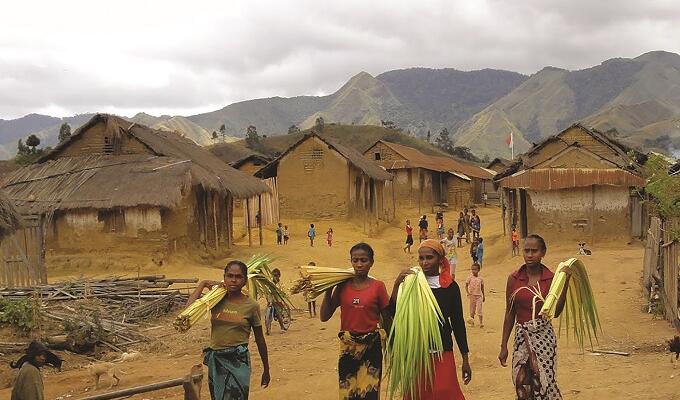


Empowering Madagascan women with environmental know-how
It is somewhat ironic that with more than 3 billion people, the rural poor, who have very little in the way of personal resources, constitute the largest group of natural resource managers. Within this group, women have a key role in sourcing natural resources as farmers and household providers. They are responsible for harvesting, collecting of fuel and water and cultivating subsistence crops.
Despite providing in large measure
for their family needs, women are often
denied natural resource governance functions
within their communities. By contrast,
men are dominating governing roles such
as commercializing land, water, plants and animals and thus generating income for their
community.
Due to degradation of natural resources
caused by climate change and biodiversity
loss, women are dedicating an increasing
amount of time to sourcing natural
resources, such as walking longer distances
for collecting fuelwood and water and harvesting
wild plants.
However, women can act as effective agents of change in relation to the conservation of biodiversity as well as climate change mitigation and adaptation. Their role as stewards of natural and household resources positions them well to advocate climate-smart strategies to build resilient communities.
Madagascar makes a good example. According to the World Bank, two-thirds of the country’s population is living in rural areas. With more than 40 protected areas accounting for around 2 million hectares of land, the livelihoods of the majority of rural people depend on sourcing natural resources from the buffer zones surrounding those areas.
BIODIVERSITY HOTSPOTSMadagascar’s forests are biodiversity hotspots,
home to species found nowhere else.
At the same time, the country faces stern
development challenges: high poverty rates,
population growth and slow economic development.
Its unique forest habitats face grave
threats from slash-and-burn agriculture and
illegal logging, exacerbating the fallout from
changing temperature and rainfall patterns.
Fibres from raffia palms have long been
used for making traditional handicrafts,
twine, rope and clothing. More recently,
woven hats and bags made from raffia have
started to find favour in the international
fashion industry. However, this has not yet
translated into a payoff for the women’s
cooperatives that typically process raffia and
sell it on to traders as raffia yields have been
battered by deforestation and climate change.
The International Trade Centre (ITC) is
working with the Wildlife Conservation
Society (WCS) to build climate resilience,
improve sustainability practices and raise
incomes in communities reliant on raffia for
their livelihoods.
As yields decline the women’s associations
must improve harvesting practices and
upgrade processing and quality to meet the
exacting standards of international buyers.
To maximize the prices they receive, they
need to complement increased productivity
with improved product design and direct
sales to international buyers.
In areas surrounding the WCS-managed Makira National Park, ITC is training women’s associations on climate-change adaptation and climate-smart raffia harvesting and processing techniques as well as organizational management.
By increasing incomes for households
near the park, one of the country’s largest
remaining mid-elevation tropical forests,
the programme aims to reduce dependence
on unsustainable exploitation of natural
resources while engaging local communities
as collaborative managers in the 372,000-hectare
park’s conservation activities.
ITC and WCS conducted training
workshops in 2015 for around 200 women
from six women’s associations in the Makira
area, on raffia harvesting, sorting, drying,
tanning, quality improvements, product
design and planting aimed at ensuring climate
resilience and long-term profitability.
This capacity building was implemented
in two stages. First, 24 women representing
six individual federations in total
were equipped to train fellow association
members in the long run. Next, week-long
training workshops were held in multiple
villages for some 180 women from the six
associations.
‘During the training, we learnt a lot
about raffia and we are now crafting betterquality
items,’ said Florine Zafijery, a member
of one of the associations benefitting
from the project.
As a result of the workshops the women
in the buffer zones of Makira Park are now
following more sustainable techniques of
raffia sourcing. For instance, they learned to
source raffia leaves only during the dry season.
Furthermore, the associations learned
to harvest leaves of a minimum length of
120 centimetres to reach the maximum
length. They were also trained in reforestation
techniques to ensure long-term raffia
sustainability.
The programme’s training activities
will expand in 2016 to cover eight additional
women’s associations in the Makira Park area, bringing the total number of beneficiaries
to 450. Furthermore, two women
from each of the participating groups will
receive intensive training on product design
and manufacture for the international market,
enabling them to train their peers with
the goal of better equipping the associations
to sell value-added products.
For its part ITC will build on its market- connecting work to create a network of potential raffia purchasers. Together with WCS, ITC will help the associations enhance their legal status so they can more easily strike contracts with international buyers. ITC will also assist the associations in leveraging its Blue Number initiative, a global online network and tracking system for farms and agro-industry, to garner increased visibility on the raffia value chain.
BOLSTERING LIVELIHOODSThe raffia project is the first step in
broader collaboration between ITC and
Madagascar’s trade and environment ministries
to promote exports of sustainable natural
resources to bolster rural livelihoods and
while conserving biodiversity.
Empowering rural women with environmental
knowledge and market intelligence is
the key to giving them a voice in community
based natural resource management. It enables
them to source, manage and trade their
produce locally and internationally, thus generating
additional income for their communities
and improving livelihoods.



